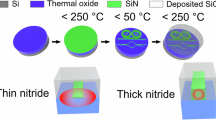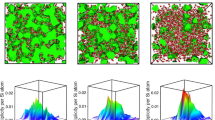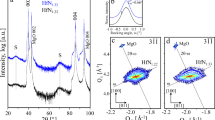Abstract
THE incorporation of nitrogen in oxide glasses can lead to improved physical properties such as hardness and refractive index1–4; one might accordingly expect to see a further improve-ment in glasses containing nitrogen as the only anion. But while there are now many examples of non-oxide glasses in the halide and chalcogenide families5–8, the formation of pure nitride glasses has not hitherto been demonstrated. Here we report the formation of glasses in the system Li3N-Ca3N2-P3N5, by the rapid quenching of fused mixtures of the nitrides at high pressures. The use of high-pressure conditions prevents thermal decomposition of the nitride mixtures to gaseous nitrogen. The new nitride glasses are stable in air, have remarkably high refractive indices (1.97–2.0), hardness exceeding that of silica glass, and high glass transition tempera-tures (7g > 700 °C).
This is a preview of subscription content, access via your institution
Access options
Subscribe to this journal
Receive 51 print issues and online access
$199.00 per year
only $3.90 per issue
Buy this article
- Purchase on SpringerLink
- Instant access to full article PDF
Prices may be subject to local taxes which are calculated during checkout
Similar content being viewed by others
References
Jack, K. H. J. Mater. Sci. 11, 1135–1158 (1976).
Loehman, R. E. J. non-cryst. Solids 42, 433–446 (1980).
Loehman, R. E. J. non-cryst. Solids 56, 123–134 (1983).
Sakka, S. A. Rev. Mater. Sci. 16, 29 (1986).
Lucas, J. J. Mater. Sci. 24, 1–13 (1989).
Poulain, M. Nature 293, 279–280 (1981).
Rawson, H. Inorganic Glass-Forming Systems (Academic, New York, 1967).
Zarzycki, J. J. Glasses and the Vitreous State (Cambridge Univ. Press, 1990).
Larson, R. W. & Day, D. E. J. non-cryst. Solids 88, 97–113 (1986).
Holloway, J. R. & Wood, B. J. Simulating the Earth: Experimental Geochemistry (Unwin Hyman, Boston, 1988).
Wells, A. F. Structural Inorganic Chemistry (Clarendon Press, Oxford, 1984).
Chase, M. W. et al. Janaf Thermochemical Tables 3rd edn (American Chemical Soc., Washington DC, 1985).
Schnick, W. & Luecke, J. Z. anorg. allg. Chem. 588, 19–25 (1990).
Schnick, W. & Luecke, J. J. Solid St. Chem. 87, 101–106 (1990).
Schnick, W. Angew. Chem. int. Edn Engl. 32, 806–807 (1993).
Schnick, W. & Berger, U. Angew. Chem. int. Edn engl. 30, 830–832 (1991).
Bunker, B. C. et al. J. Am. Ceram. Soc. 70, 675–681 (1987).
Schnick, W. & Luecke, J. Solid St. Ionics 38, 271–273 (1990).
Rabenau, A. Solid St. Ionics 6, 277–293 (1982).
Author information
Authors and Affiliations
Rights and permissions
About this article
Cite this article
Grande, T., Holloway, J., McMillan, P. et al. Nitride glasses obtained by high-pressure synthesis. Nature 369, 43–45 (1994). https://doi.org/10.1038/369043a0
Received:
Accepted:
Issue date:
DOI: https://doi.org/10.1038/369043a0



